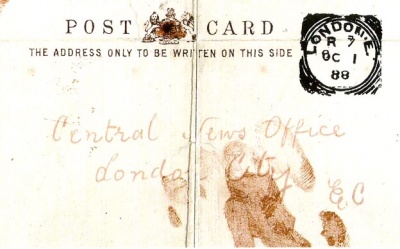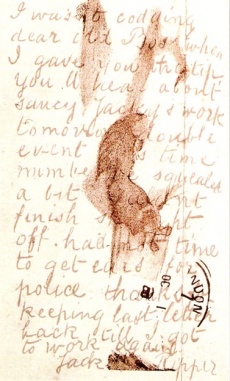Saucy Jacky Postcard
Colloquial name generally given to a postcard received by the Central News Agency on the morning of 1st October 1888[1]. It was a pre-stamped card in common use at the time, however the copying method of the Victorian era failed to register the blue colour of the printed 'stamp' and thus it does not appear on the various copies now available. Both message and address were written in red pencil/chalk. Both sides of the postcard were smeared with what appeared to be blood, the address side bearing traces of finger or thumb prints.
It was addressed to 'Central News Office, London City E.C' and postmarked 'LONDON OC 1 88'.
Transcription
I was not codding dear old Boss when I gave you the tip, you'll hear about Saucy Jacky's work tomorrow double event this time number one squealed a bit couldn't finish straight off. ha not the time to get ears for police. thanks for keeping last letter back till I got to work again.
Jack the Ripper
Reception & Publication
The postcard contained the second use of the name 'Jack the Ripper' and unlike the Dear Boss Letter, the contents were published in the press immediately after it was received. Although considered a practical joke, it was noted that both communications were written by the same individual owing to the unmistakeable similarities in handwriting between the postcard and the postscript of the original letter. A facsimile of the postcard was published in tandem with that of the Dear Boss Letter on 4th October[2].
In a letter to The Times, one Fred. W. P. Jago of Plymouth made an important point regarding the smeared 'blood':
Sir, - Another remarkable letter has been written by some bad fellow who signs himself, "Jack the Ripper." The letter is said to be smeared with blood, and there is on it the print in blood of the corrugated surface of a thumb. This may be that of a man or a woman. It is inconceivable that a woman has written or smeared such a letter, and therefore it may be accepted as a fact that the impression in blood is that of a man's thumb. The surface of a thumb so printed is as clearly indicated as are the printed letters from any kind of type. Thus there is a possibility of identifying the blood print on the letter with the thumb that made it, because the surface markings on no two thumbs are alike, and this a low power used in a microscope could reveal.
I would suggest - (1) That it be proved if it is human blood, though this may not be material; (2) that the thumbs of every suspected man be compared by an expert with the blood-print of a thumb on the letter; (3) that it be ascertained whether the print of a thumb is that of a man who works hard and has rough, coarse hands, or whether that of one whose hands have not been roughened by labour; (4) whether the thumb was large or small; (5) whether the thumb print shows signs of any shakiness or tremor in the doing of it.
All this the microscope could reveal. The print of a thumb would give as good evidence as that of a boot or shoe. I am , yours, &c.,[3]
This was a perfectly reasonable suggestion, unfortunately Mr. Jago's ideas had yet to gain common usage (fingerprinting for criminal identification had been offered to the Metropolitan Police in 1886 ,but was turned down[4]. The first conviction for murder based on fingerprint evidence was in Argentina in 1892).
Opinion
The Saucy Jacky postcard has often been cited in the past as potentially genuine on account of it being received on the morning of the day after the 'Double Event', which by modern standards suggests it was posted before the news was common knowledge. If this is to be accepted, then the Dear Boss Letter may also be considered genuine. Realistically, this is hardly the case. Knowledge of the 'double event' would have been widespread throughout the day of the murders, 30th September. Also, the postal service in the Victorian era was considerably more efficient (by necessity) than today, with many more collections which included Sundays. The postcard could easily have been written on the 30th September and posted in plenty of time to arrive at the Central News Agency on the 1st October.
Status
The original postcard is now missing and it is not clear how long this has been the case. All copies in private collections are facsimiles of varying age and the 1888 Metropolitan Police copy is stored at the National Archives[5]. As with all Ripper-related documents, public access is limited.
References
- ↑ The Star, 1st October 1888
- ↑ Evening News, 4th October 1888
- ↑ The Times, 4th October 1888
- ↑ Dr. Henry Faulds - Beith Commemorative Society - Journal of Forensic Identification Vol.53; Donald L. Reid (2003)
- ↑ MEPO 3/142, ff.2-3
See also Letters From Hell; Stewart P Evans & Keith Skinner, (Sutton 2001).


